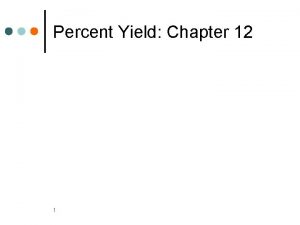Comparing theoretical irrigation requirement and actual irrigation for

- Slides: 1

Comparing theoretical irrigation requirement and actual irrigation for citrus in Florida 1 Consuelo C. Romero , Michael D. Dukes 1, Guillermo A. Baigorria 1, and Ron Cohen 2 1 Agricultural and Biological Engineering Department, University of Florida, Gainesville, FL. 2 Southwest Florida Water Management District, Brooksville Headquarters, FL. Hillsborough • Water balance considerations Florida ranks first in citrus production with nearly 68% of all U. S. citrus (2005 -2006), with microsprinkler irrigation as the standard delivery method. Growing water demands resulted in declines in aquifer levels throughout the southern portion of the Southwest Florida Water Management District (SWFWMD) area called the Southern Water Use Caution Area (SWUCA). SWFWMD implemented new recovery strategy in 2006 to help address water supply problems so that permitted amounts were more representative of actual water use. Agricultural irrigation permitting is regulated by SWFWMD based on the AGMOD computer program. • Objective To compare the actual reported irrigation water use in Highlands, Hillsborough and Polk counties with permitted values as well as theoretical consumptive use values calculated by a daily water balance. Irrigation depth (mm) • Justification Soil depth: 0. 9 m Runoff and drainage: assumed as zero Two sets of monthly Kc values tested: Jia et al. (2007) and Morgan et al. , (2006). Two wetted areas tested: 40 and 60% Irrigation efficiency for microsprinkler irrigation: 80% Highlands • Results 40% wetted area Polk 60% wetted area Figure 4: Simulated gross irrigation requirements estimated by using Jia et al. (2007) Kc data set and 40 and 60% wetted areas. The upper and lower edges of the whisker plots indicate the 75 th and 25 th percentiles of the results. The end of the vertical lines indicates the 100 th and 0 th percentiles, from top to bottom. The median (50 th percentile) is shown as a short line in the box. The black and gray lines represent the 2 -in-10 and 5 -in-10 permitted irrigation requirements, respectively. Diamonds represent the multiannual mean water pumped by growers. Figure 3: Multiannual average rainfall for the three counties. Year Figure 1: SWFWMD permitted irrigation amounts for Hillsborough, Highlands and Polk counties shown as a solid black line (2 -in-10) and solid gray line (5 -in-10) irrigation requirement. Mean annual water use by growers values as red diamonds +/- one standard deviation are shown as error bars. The 2 -in-10 and 5 -in 10 permitted irrigation requirements represent the amount of water that would provide adequate irrigation for crop production in 80 and 50% of the future years, respectively. • Weather station network Max and min temperature, incoming solar radiation, max and min relative humidity, wind speed, and rainfall were available for two main weather stations from SWFWMD (Figure 2). Rainfall data were available for 48 sites, from 1994 through 2005 (Figure 3). • Missing data problem. Missing data ranged from: 25 to 49% for incoming solar radiation, 20 to 58% for both, max and min temperatures, 44 to 62% maximum relative humidity, 43 to 62 % for minimum relative humidity, 7 to 44 % average wind velocity, 2 to 8% rainfall in Highlands, 0 to 23% in Hillsborough, and 0. 8 to 8% in Polk counties. Figure 5: Simulated gross irrigation requirements estimated by using Morgan et al. (2007) Kc data set and 40 and 60% wetted areas. The upper and lower edges of the whisker plots indicate the 75 th and 25 th percentiles of the results. The end of the vertical lines indicates the 100 th and 0 th percentiles, from top to bottom. The median (50 th percentile) is shown as a short line in the box. The black and gray lines represent the 2 -in-10 and 5 -in-10 permitted irrigation requirements, respectively. Diamonds represent the multiannual mean water pumped by growers. • Data estimation & generation • Materials and Methods • Water use by growers Reported pumped data from citrus production areas in the three counties were provided by the SWFWMD for 1994 through 2005, including the number of farms, and irrigated area (Table 1). The SWFWMD also provided the permitted citrus irrigation amounts for each county per year (Figure 1). • The Hargreaves-Samani (1982) model was used to estimate incoming solar radiation data using complete databases from auxiliary WSt. The weather generator WGEN (Richardson and Wright, 1984) was used to generate missing values of rainfall, temperature, humidity and wind velocity. The multiannual average water consumption from growers ranged from 244 mm in Hillsborough to 406 mm in Highlands and the multiannual average irrigation requirement permits ranged from 295 to 557 mm. Table 1: Number of farms, mean monthly reported pumped water and mean production area reported by farms in Highlands, Hillsborough and Polk counties. Year 1994 1995 1996 1997 1998 1999 2000 2001 2002 2003 2004 2005 Highlands Hillsborough # of farms Mean water use (mm) Mean area (ha) # of farms 46 55 84 85 60 90 96 83 86 98 75 66 385 362 527 446 501 432 557 397 377 337 320 230 125 123 107 108 115 106 100 106 101 91 105 109 5 11 24 19 7 21 31 22 13 12 17 10 Polk Mean water Mean # of farms Mean water Mean use (mm) area (ha) 174 229 208 157 292 428 316 294 198 205 192 166 97 77 89 66 83 58 55 64 57 62 67 44 45 136 117 76 164 163 145 118 122 71 75 277 297 426 397 465 432 554 392 341 310 205 Annual simulated gross irrigation requirements followed the trend of the actual pumped water by growers. Pumped water by growers fell the range of the simulated gross irrigation requirement. 111 99 70 75 85 69 69 70 79 77 88 85 • Conclusions Figure 3: Map showing Highlands, Hillsborough and Polk counties, Florida, and the spatial distribution of weather stations across the area. • Reference ETo estimation • Soil data Citrus groves are typically established in the flatwoods or ridge. The soil characteristics used in this study were: Highlands and Polk: Astatula sand (ENTISOL) Hillsborough : 7% field capacity, 4% permanent wilting point 3% available water holding capacity Basinger (ENTISOL) 12% field capacity, 5% permanent wilting point 7% available water holding capacity ASCE-EWRI Standardized reference ET equation was used (ASCE-EWRI, 2005) from 1994 to 2005 on a daily basis • Water balance The soil water balance equation was represented as follows: Despite the uncertainty generated in the simulations, the permitted irrigation values recommended by the SWDWMD seem to be reasonable for the actual water use by growers in Hillsborough and Highlands. Simulated irrigation values for Polk exceeded the 2 -in-10 permit limit when using 60% wetted area, either Kc data set, which makes us think that the established limits might need some adjustment for this county. There is still a lack of inter-annual variability in the established permitted values. Further research must consider using forecasts to establish permit limits in the District. References ASCE-EWRI. 2005. The ASCE Standardized Reference Evapotranspiration Equation. Technical Committee report to the Environmental and Water Resources Institute of the American Society of Civil Engineers from the Task Committee on Standardization of Reference Evapotranspiration. 173 pp. Hargreaves, G. and Samani, Z. 1982. Estimating potential evapotranspiration. J. Irrig. Drain. Eng–ASCE, 108: 225 -230. Where SWt is the soil water on day ‘t’, SWt-1 is soil water content, ETct-1 is the crop evapotranspiration, Rt-1 is the rainfall, It-1 is net irrigation, Dt-1 is drainage and Roff t-1 is runoff. Richardson, C. W. and Wright, D. A. 1984. WGEN: a model for generating daily weather variables. USDA, Agricultural Research Service, ARS-8. Jia, X. , Swancar, A. , Jacobs, J. M. , Dukes, M. D. and Morgan, K. 2007. Comparison of evapotranspiration rates for flatwoods and ridge citrus. Trans. ASABE 50(1): 83 -94. Morgan, K. T. , Obreza, T. A. , Scholberg, J. M. S. , Parsons, L. R. and Wheaton, T. A. 2006. Citrus water uptake dynamics on a sandy Florida Entisol. Soil Sci. Soc. Ame. J. , 70(1): 90 -97 Acknowledgments The authors gratefully acknowledge funding from the Southwest Florida Water Management District and the Florida Agricultural Experiment Station that made this work possible.

